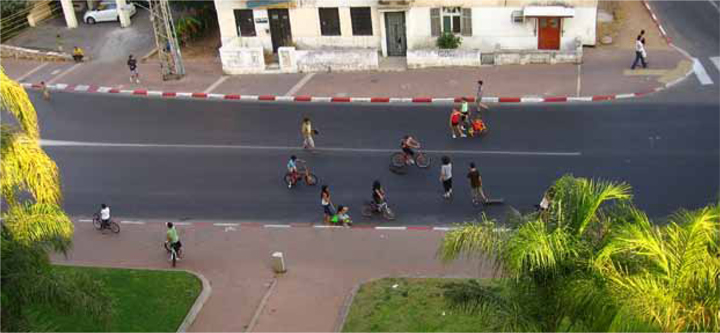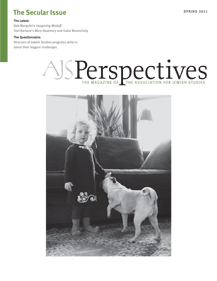
After finishing the late evening Yom Kippur prayer in the nearby Great Synagogue, a group of male and female college students from the United States and Canada belonging to the Nativ youth movement were hugging each other and devoutly singing Jewish religious songs from some photocopies entitled "The Nativa-Tish." They were sitting on the ground in the middle of one of Jerusalem's main intersections, not far from the prime minister's residence. "I'm from Vancouver," one of the singers told me enthusiastically, "I came over here for a year to study at the Hebrew University. Back home this is a regular day with cars driving around. Can you imagine? Here it is the holiest day. No one drives, the roads are empty, and we're here to celebrate this." A small crowd was watching the scene. Some, dressed in white and other holiday clothes, were singing along. Tourists were taking pictures (not too many ultra-Orthodox or haredim were around to stop them). Children on bicycles encircled the group before continuing their adventure in nearby neighborhoods; a few non-observant Jews, secular Israelis (hilonim), were taking a walk in the quiet streets, stopping for a moment to curiously watch the young group singing.

Yom Kippur scenes offer yet another opportunity to rethink secularism in the Jewish-Israeli context and perhaps in other modern nation-states as well. In particular, the above scene—the transformation of the streets into a semi-religious space with a complete (religious) sabbatical, where singing and praying continues amidst the (secular) mixing of the genders by a religious group (right after praying in a strictly Orthodox setting of gender separation) while the secular crowd walks and cycles around—demonstrates how secularism is part of religion and vise versa. The famous "secularism thesis" according to which religious institutions are declining in modernity, especially in the public sphere, is still debated among scholars. As my colleague, Yossi Yonah, and I argued in Maelstrom of Identities (2004, in Hebrew), secularism in modern nation-states, including Israel, has never been complete. It is a hybrid process that has always been intermingled with religion. Furthermore, secularism is different for different countries, both in its politics and in its historical trajectories.
When inquiring into secularism(s) scholars should try to combine the ethnographic details, the nuanced meaning of non-religious realities, with the broader political milieu in which these are worked out. Secularism, however, is not an empirical question alone. It is also a moral question insofar as it is tied up with political ideologies about the nature, structure, and values that should govern the public sphere. Lay persons and scholars alike evaluate secularism not only in relation to objective, value-free understanding of its meaning but also in relation to what they consider the (ideal) prototype of a modern public sphere. When scholars argue that because religion plays such a major role in defining Israel's politics, the observance of Yom Kippur is merely an example of how Israel is not a "true" liberal state—they implicitly have in mind an ideal Protestant state (like the United States.).
Furthermore, these moral questions are ever changing together with the slow political and ideological transformations in Israel and elsewhere. Secularism and religiosity in the Israeli public sphere on Yom Kippur makes the issue of such evolving moralities stand out most powerfully because religion and secularism are worked out in new non-institutionalized ways. Religious and secular forms are retranslated. The empty streets open up a space for action and thought that is not easily bent into known forms and meanings. The new possibilities to celebrate the day create deep moral deliberations about life, rights, values, and tradition. Thus, the very decision to sit on the ground and sing together, to ride bicycles, talk quietly, and watch what others are doing in these urban spaces are all moral acts that are constantly problematized in Israel. Indeed, the Yom Kippur happenings in the streets and homes of Israelis are worked out in light of, and in the shadow of, public contestations about the legitimate and appropriate celebration of the most sacred day in Jewish tradition.
A recent public debate about the ideal Yom Kippur in Israel, published on the website of Israel's most popular daily newspaper, exemplifies this evolving process. The two main voices base their proposals on the mundane realities in Israel, although each sees and evaluates them differently. The first is Rabbi Israel Meir Lau, former Ashkenazi Chief Rabbi of Israel. He criticizes seculars who rent video cassettes(!) or spend the day riding their bicycles. These Jews, he argues, are missing a golden opportunity. He then writes (my translation):
The most enchanting hour is approaching. This is the twilight hour in which a multitude of people—men, women and small children—are marching to thousands of synagogues spread all around the country for the Kol Nidre prayer. Most are dressed in white, the men with white yarmulkes on their heads and prayer shawls on their shoulders or under their arms, men and women with white canvas shoes. All are flowing throughout the cities' streets in this unique hour, when the road and sidewalk are the same. "May you be inscribed in the book of life," "Have a good year," "All the best," are the expressions heard; no disgraceful, defamatory, or reviling shouting is heard. In the air, one feels the saying "All Jews are responsible to one another." Indeed this is an enchanting hour that heralds the sanctification of Yom Kippur governing merely twenty-five hours each year. In respect to our tradition and appreciation of our fathers' and grandfathers' inheritance and in the name of solidarity, so often talked about and so seldom acted upon, I approach you with fondness, calling you to pick up yourselves and your children and come to the synagogues that are widely open for Kol Nidre and for other prayers of the day, including the spirits-memorial-service (azkarat neshamot) and the closing prayer (neilah), which are all so unique in their ability to unite all parts of our nation. Your children should know that Kol Nidre's melody was tailored for the Marranos of Spain who were forced for the fear of the Inquisition to live as converts on the outside and in the evenings of Yom Kippur used to descend to cellars and there cancel their year's vows, because they knew that this day can expunge misdeeds, atone for sins, and open up a new clean and pure page for next year.
Rabbi Lau moves from the ethnographic account of the quiet streets (underscoring the religious people approaching the synagogues) to a moral call to the nonobservant. He assumes a necessary continuity between the religious and the seculars in Israel along the lines of Jewish halakhic law. He even hints that the seculars in Israel are like the Marranos in Spain. In particular, he assumes that there is only one acceptable way to celebrate Yom Kippur—the Orthodox way.
An alternative call is made by Itamar Bar Tor, a secularist. Bar Tor first refers to the way Tel Aviv, the largest urban center in Israel, turns for one day into what looks like a quiet village reminiscent of the city his parents told him about, a city in which neighbors used to go outside with their chairs to sit together and talk. He then writes:
Some complain that "Yom Kippur has turned into the bicycle-holiday, and that the prayer book (mahzor) has been replaced by the skateboard." A deeper contemplation would allow us, however, to see that the secular holiday, whether intended or not, holds an intrinsic content of its own. This is a day in which we return to the slow, nondigital world of the past. This is a day in which we discover anew the community, when people and groups of neighbors, converse with one another into the night. This is also a day of return to the family. Without the mediation of TV and without the need to spend time in yet another attraction, the bicycle journeys are turning into a renewed family journey. And, of course, within the general atmosphere of self-examination, this is a day that everyone looks deeply into themselves, in the spirit of "You should know where you came from and where you are heading." Simply put, the secular Yom Kippur is the day of return to ourselves. Or, if you may, using the terms of religious people (dossim), it is the Day of Return.
Bar Tor holds that a secular holiday should be framed in terms of an explicit morality. Merely wandering about on bicycles cannot count as a holiday that is worth the name. His morality is not supported by old Jewish traditions and history (which he mentions with an ironic twist) but in the name of the recent, early modern, reality of local intimate urban communities and family life. With the evolving secular realities of the day, he combines past Israeli urban ways of life, values of individuality, introspection, small communities' sense of togetherness, and some Jewish notion of "return"—turning them all into a moral call for a new, secular Yom Kippur.
These columns were followed by hundreds of responses. While many readers supported Rabbi's Lau message, many criticized it. They expressed a secular ideological rejection of Jewish tradition, especially the way it is politically forced upon seculars in Israel. Others were happy to discover new meanings in their Yom Kippur celebrations through Bar Tor's reading of their experience.
Such debates suggest that although secularism and religion are hybrid categories, they are not completely fluid and interchangeable (not "everything goes"). Ideologies, structures, definitions, and discourse do matter. Still, debates between religious people and seculars and among each group are interesting and cannot be taken for granted. They are full of surprises because participants need to rethink their morality and identity in new and elusive situations. Both Rabbi Lau and Bar Tor observe the new Jewish-Israeli urban spaces, which are filled with a mixture of religious and secular actions. In response, both offer creative, yet diverse, interpretations based on current scenes, past memories and sentiments, and all these are tied up with their evolving moralities around issues of Judaism and Zionism.
Secularism and religion are intertwined— both empirically and analytically— through complicated political, historical, social, and moral processes. As my opening ethnographic vignette and the debates on the "right" Yom Kippur demonstrate, religion and secularism constantly inform each other, like self and its Other, or object and its background. Still, scholars should, I suggest, pay more attention to secularism as the object of their anthropological inquiry. Secularism is worked out in Israel in the face of a multitude of possibilities and traditions and in the face of a powerful Jewish Orthodox milieu. Furthermore, its understanding is worked out in the face of a still-dominant protestant (moral) assumption about the modern public sphere. New inquiries into secularism will thus shed much needed light on the meaning of the modern public sphere and its evolving morality.

